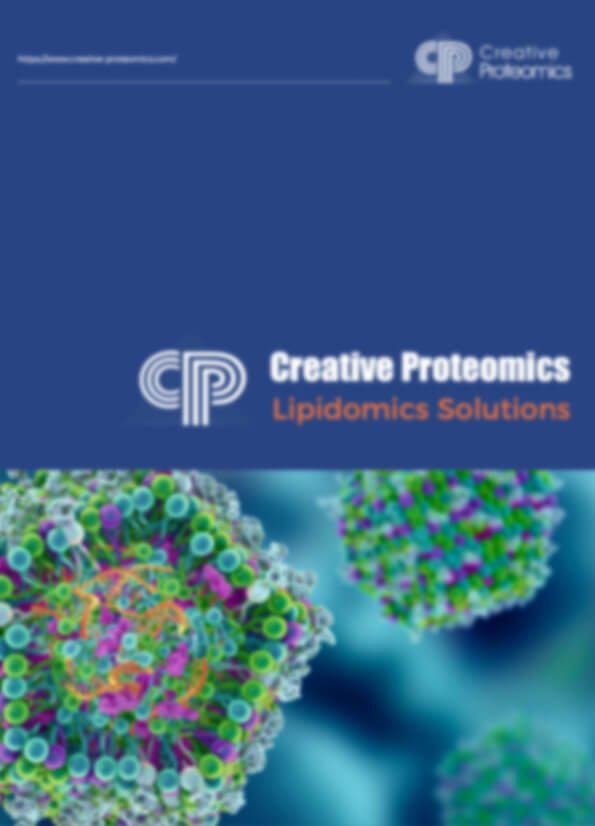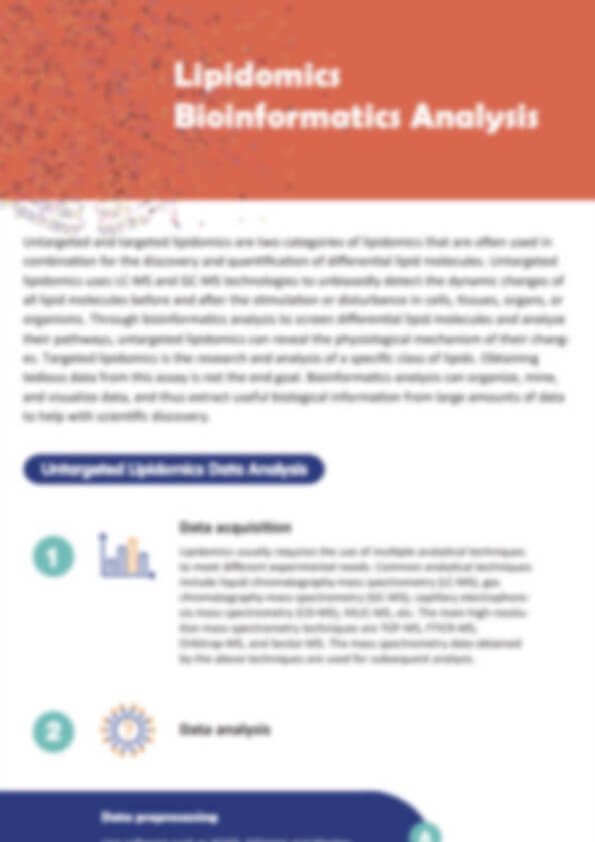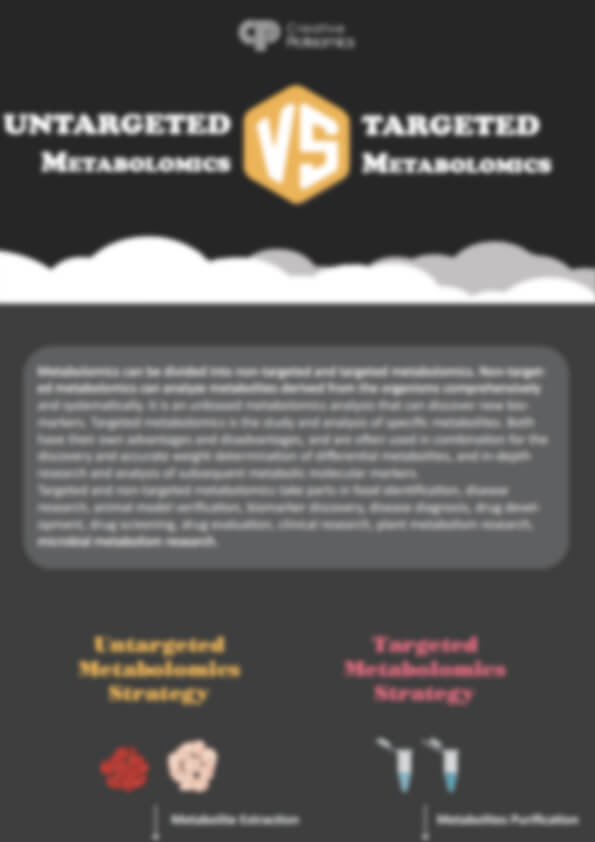Oxylipin Analysis Service
Creative Proteomics specializes in oxylipins analysis, offering precise quantification of bioactive lipid mediators using advanced LC-MS/MS and GC-MS/MS platforms. We provide targeted and untargeted analysis to support lipidomics research, environmental studies, and pharmacological investigations. Our services deliver high-sensitivity detection, comprehensive pathway insights, and customizable solutions to help researchers decode oxylipin metabolism, understand lipid signaling pathways, and optimize experimental outcomes with reliable, high-quality data.
Submit Your Request Now
×- What We Provide
- Advantages
- Technology Platform
- Workflow
- Sample Requirements
- FAQ
- Publications
What is Oxylipins?
Oxylipins are oxygenated derivatives of polyunsaturated fatty acids (PUFAs), including arachidonic acid (ARA), linoleic acid (LA), α-linolenic acid (ALA), eicosapentaenoic acid (EPA), and docosahexaenoic acid (DHA). These bioactive lipid mediators are synthesized through enzymatic pathways (e.g., COX, LOX, CYP450) or non-enzymatic oxidation. Functionally, oxylipins regulate critical physiological processes such as inflammation, immune response, cardiovascular homeostasis, and oxidative stress. Dysregulation of oxylipin profiles is implicated in diverse pathologies, including metabolic disorders, neurodegenerative diseases, and plant defense mechanisms.
Oxylipins Analysis Service Offered by Creative Proteomics
- Targeted Oxylipin Quantitation: Absolute quantification of 76+ oxylipins using isotope-labeled internal standards.
- Pathway-Specific Panels: Focused analysis of COX/LOX/CYP450-derived metabolites (e.g., prostaglandins, leukotrienes).
- Customized Panels: Flexible selection of analytes based on biological pathways or research objectives.
- Non-Targeted Screening: Discovery-driven identification of novel oxylipins and metabolic intermediates.
- Multi-Omics Integration: Combine oxylipin data with transcriptomic/proteomic datasets for systems biology insights.
Comprehensive List of Oxylipins & Related Metabolites
| Precursor | Detected Oxylipins & Related Metabolites | Metabolic Pathways/Key Enzymes |
|---|---|---|
| Arachidonic Acid (ARA) | Prostaglandins (PGE₂, PGD₂, PGF₂α, PGI₂/Prostacyclin), Thromboxanes (TXB₂, TXA₂), Leukotrienes (LTB₄, LTC₄, LTD₄), HETEs (5-, 12-, 15-HETE), HpETEs (5-, 12-HpETE), EETs (5,6-, 8,9-, 11,12-, 14,15-EET), Lipoxins (LXA₄, LXB₄), Isoprostanes (8-iso-PGF₂α) | COX-1/2, LOX (5-LOX, 12-LOX, 15-LOX), CYP450 (CYP2C, CYP2J), autoxidation |
| Linoleic Acid (LA)/α-Linolenic Acid (ALA) | 9-/13-HODE, 9,10-EpOME, 12,13-EpOME, 9,10-DiHOME, 12,13-DiHOME, KODEs (keto-ODE), Isofurans, Isolevuglandins, Phytoprostanes (PPs) | LOX, CYP450, autoxidation |
| EPA/DHA | Resolvins (RvD1, RvD2, RvE1, RvE2), Protectins (PD1, PDX), Maresins (MaR1, MaR2), Neuroprotectin D1 (NPD1), 17,18-EpETE, 19,20-EpDPE, 19,20-DiHDPA, 14,15-EpETrE | LOX, CYP450, autoxidation |
| Plant-derived | 12-oxo-Phytodienoic acid (OPDA), Dinor-OPDA, Traumatin, Jasmonic acid, Methyl jasmonate, Volatile GLVs ((Z)-3-hexenal, (E)-2-hexenol), Green leaf volatiles (C₆ aldehydes/alcohols) | LOX, Hydroperoxide lyase (HPL), Allene oxide synthase (AOS), peroxygenase |
| Microbial/Other | 10-Hydroxy-8(E),12(Z)-octadecadienoic acid (10-HOD), 10-Oxo-12(Z)-octadecenoic acid (10-KODE), Microbial PUFA derivatives (e.g., oxylipins from Fusarium spp.) | Microbial LOX, CYP450, peroxygenase |
| Precursor | Detected Oxylipins & Related Metabolites | Metabolic Pathways/Key Enzymes |
Advantages of Oxylipins Assay
- Multi-Technology Integration: Simultaneous quantification of 300+ oxylipins with sub-picomolar sensitivity using LC-MS/MS (SCIEX QTRAP 6500+), UHPLC (Agilent 1290 Infinity II), and GC-MS/MS (Agilent 7890B/7000D).
- Unparalleled Sensitivity and Precision: Detect ultra-low abundance mediators at 0.01 pg/mL with isotopic dilution and maintain assay CV <8%.
- Robust Anti-Oxidation Workflow: Prevent auto-oxidation using nitrogen-based extractions and matrix-specific SPE cartridges ensuring >95% lipid recovery.
- Cross-Species and Multi-Matrix Compatibility: Analyze diverse samples from human plasma, plant extracts, microbial cultures, and processed foods with tailored hydrolysis protocols.
- Wide Dynamic Range and High Throughput: Achieve 5–6 orders of linearity (1 pg/mL–100 ng/mL) and process 200+ samples weekly with automated workflows.
- Advanced Data Analysis Suite: Perform pathway mapping using KEGG and LIPID MAPS, with seamless integration into multi-omics platforms like Skyline and MetaboAnalyst.
- Customizable and Scalable Solutions: Transition from discovery to validation with tailored panels, combining oxylipins with fatty acid precursors and secondary mediators.
Technology Platform for Oxylipins Analysis Service
Liquid Chromatography-Tandem Mass Spectrometry (LC-MS/MS)
- Instrument Model: SCIEX QTRAP 6500+
- High selectivity and sensitivity for targeted oxylipin quantification.
Ultra-High Performance Liquid Chromatography (UHPLC)
- Instrument Model: Agilent 1290 Infinity II
- High-resolution chromatographic separation for complex oxylipin mixtures.
Gas Chromatography-Mass Spectrometry (GC-MS/MS)
- Instrument Model: Agilent 7890B GC coupled with 7000D MS/MS
- Suitable for volatile oxylipin derivatives.
HPLC-UV (High-Performance Liquid Chromatography with UV Detection)

Agilent 1260 Infinity II HPLC (Figure from Agilent)
GC-MS (Gas Chromatography-Mass Spectrometry)

Agilent 7890B-5977B (Figure from Agilent)
LC-MS/MS (Liquid Chromatography-Tandem Mass Spectrometry)

SCIEX Triple Quad™ 6500+ (Figure from Sciex)
LC-MS

Q Exactive™ Plus Hybrid Quadrupole-Orbitrap™ Mass Spectrometer (Figure from Thermo)
Workflow of Oxylipins Analysis in Biological Samples
 Scheme of the complete analytical procedure of oxylipins (Liakh, Ivan, et al., 2019).
Scheme of the complete analytical procedure of oxylipins (Liakh, Ivan, et al., 2019).
Sample Requirements for Oxylipins Analysis Service
| Sample Type | Minimum Sample Volume/Amount | Recommended Volume/Amount | Storage Conditions | Notes |
|---|---|---|---|---|
| Plasma | 100 µL | 500 µL | -80°C | Collect using EDTA or heparin tubes, centrifuge at 4°C, and store supernatant. Avoid hemolysis. |
| Serum | 100 µL | 500 µL | -80°C | Allow blood to clot at room temperature for 30 minutes, centrifuge, and store serum. |
| Tissue (Animal or Human) | 50 mg | 100 mg | -80°C | Flash-freeze tissue in liquid nitrogen immediately and store in airtight containers. |
| Urine | 500 µL | 1 mL | -80°C | Collect midstream urine, avoid preservatives, and freeze promptly. |
| Cell Culture Medium | 1 mL | 2 mL | -80°C | Remove cells by centrifugation, collect supernatant, and store in aliquots. |
| Cerebrospinal Fluid (CSF) | 200 µL | 500 µL | -80°C | Collect using sterile techniques, minimize exposure to light, and freeze immediately. |
Applications of Oxylipins Assay Service
Comprehensive profiling of oxylipins to study lipid metabolism and biochemical pathways.
Inflammation and Immune Response Studies
Investigation of oxylipin-mediated signaling in inflammatory and immune regulation.
Nutritional and Dietary Research
Assessment of the effects of dietary fatty acids on oxylipin production and metabolic health.
Environmental and Toxicology Studies
Evaluation of oxidative stress markers and lipid peroxidation in response to environmental pollutants.
Pharmacological Research
Understanding drug-lipid interactions and assessing the impact of pharmaceuticals on oxylipin pathways.
Agricultural and Plant Biology
Analysis of plant-derived oxylipins involved in stress responses, pathogen defense, and growth regulation.
Demo
FAQ of Oxylipins Analysis Service
What is the detection limit for low-abundance oxylipins like resolvins or EETs?
Our LC-MS/MS platform (SCIEX QTRAP 6500+) achieves sub-picomolar sensitivity, with limits of detection (LOD) as low as 0.01 pg/mL for specialized mediators such as resolvins (e.g., RvD1, RvE1) and epoxyeicosatrienoic acids (EETs). Isotope-labeled internal standards ensure accurate quantification even in complex matrices like plasma or plant tissues.
Can I analyze formalin-fixed or paraffin-embedded samples?
No. Formaldehyde fixation causes cross-linking and degradation of labile oxylipins. We recommend fresh-frozen samples or tissues preserved in methanol-based solutions to maintain analyte integrity.
How are structural isomers (e.g., 5-HETE vs. 12-HETE) distinguished?
Our Agilent 1290 Infinity II UHPLC system with 1.8 μm HSS T3 columns provides high-resolution separation of isomers. For example, 5-HETE and 12-HETE are differentiated by retention time shifts (±0.3 min) and confirmed via unique MRM transitions.
What is the turnaround time for a typical project?
Standard projects are completed within 10–15 business days after sample receipt, including data normalization and statistical reports. Expedited services (7 days) are available for urgent studies.
Do you support analysis of volatile oxylipins (e.g., plant GLVs)?
Yes. Our Agilent 7890B GC-MS/MS platform is optimized for volatile derivatives like (Z)-3-hexenal and jasmonates. Headspace solid-phase microextraction (SPME) ensures sensitive detection at ppb levels in plant or microbial samples.
How do you minimize oxidative artifacts during sample preparation?
We employ anaerobic extraction chambers and antioxidant cocktails (0.01% BHT/EDTA) to prevent auto-oxidation. For lipid-rich matrices (e.g., fish oil), hydrolysis is performed under nitrogen to preserve native profiles.
Can I integrate oxylipin data with other omics datasets?
Yes. Raw data are compatible with Skyline, MetaboAnalyst, and GraphPad Prism for multi-omics correlation. Pathway enrichment analysis maps oxylipins to COX/LOX/CYP450 networks using KEGG and LIPID MAPS databases.
What sample types require special preprocessing?
- Plant tissues: Homogenize in methanol/BHT to inhibit lipoxygenase activity.
- Edible oils: Acid hydrolysis (0.1M HCl) releases esterified oxylipins from triglycerides.
- Cell cultures: Centrifuge at 10,000×g to remove debris before extraction.
Are your methods validated for microbial oxylipins?
Yes. We detect microbial-specific metabolites like 10-HOD and 10-KODE using species-optimized SPE protocols. Cross-validation with reference strains (e.g., Fusarium spp.) ensures accuracy.
How do I interpret low recovery rates for certain analytes?
Low recovery may indicate matrix interference (e.g., phospholipids in serum). We apply matrix-matched calibration curves and isotope dilution to correct for losses. Results include recovery-adjusted concentrations.
Learn about other Q&A.
Oxylipins Analysis Service Case Study
Publications
Here are some of the lipidomics-related papers published by our clients:

- Prospective randomized, double-blind, placebo-controlled study of a standardized oral pomegranate extract on the gut microbiome and short-chain fatty acids. 2023. https://doi.org/10.3390/foods13010015
- Laboratory evaluation of larvicidal and oviposition deterrent properties of edible plant oils for potential management of Aedes aegypti (Diptera: Culicidae) in drinking water containers. 2019. https://doi.org/10.1093/jme/tjz021
- Lipid Membrane Engineering for Biotechnology (Doctoral dissertation, Aston University). 2023. https://doi.org/10.48780/publications.aston.ac.uk.00046663
- Characterising Chinese Hamster Ovary cell extracellular vesicle production in biopharmaceutical manufacturing (Doctoral dissertation, University of Sheffield). 2022. https://etheses.whiterose.ac.uk/33062/
- White matter lipid alterations during aging in the rhesus monkey brain. 2024. https://doi.org/10.1007/s11357-024-01353-3
References
- Liakh, Ivan, et al. "Modern methods of sample preparation for the analysis of oxylipins in biological samples." Molecules 24.8 (2019): 1639. http://dx.doi.org/10.3390/molecules24081639
- Strassburg, Katrin, et al. "Quantitative profiling of oxylipins through comprehensive LC-MS/MS analysis: application in cardiac surgery." Analytical and bioanalytical chemistry 404 (2012): 1413-1426. https://doi.org/10.1007/s00216-012-6226-x












